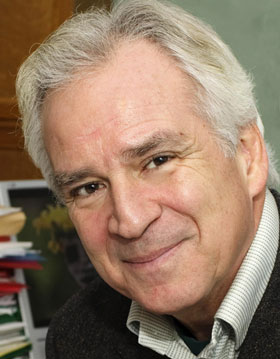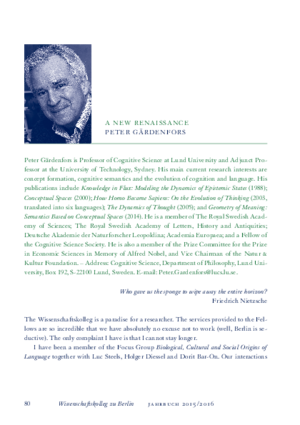
Peter Gärdenfors, Ph.D.
Professor of Cognitive Science
Lund University
Born in 1949 in Degeberga, Sweden
Studied Cognitive Science at Lund University
Schwerpunkt
Die Ursprünge von Sprache in Biologie, Kultur und GesellschaftArbeitsvorhaben
The Emergence of Meaning from Cooperative Communication: Towards an Evolutionary Theory of Semantics
Theories of language evolution tend to focus on syntactic structures. In contrast, I plan to study the evolution of semantics. Based on my earlier analyses of the connections between the evolutionary basis for cognition, collaboration and communication, I want to work on some topics that are important for the evolution of semantics: division of labour; collaboration for future goals; and the foundations for conventions and contracts. There are two kinds of cooperation typical among humans: cooperation towards future goals and indirect reciprocity. Reciprocal altruism ("you scratch my back and I'll scratch yours") is found in several animal species. Indirect reciprocity is a more extreme form of altruism: "I help you and somebody else will help me." The game-theoretical conditions for this to evolve as an evolutionarily stable strategy have recently been modelled. The crucial aspect for my argument is that these conditions presume complex forms of intersubjectivity and communication.The central cognitive requirement for conventions is that they presuppose enduring joint beliefs or common knowledge. In general, joint beliefs form the basis for much of human culture. Commitments and contracts are special cases of cooperation about the future involving joint beliefs. When you commit yourself to someone to do some action, you intend to perform the action in the future; the other person wants you to do it and intends to check that you do it; and you and they have joint beliefs concerning these intentions and desires. Commitments cannot arise unless the agents have the capacity for cognitive foresight and can form joint beliefs. A contract also depends on the possibility of future sanctions.
For the semantic theme, I build on a cognitive model of events that I have developed together with Massimo Warglien and use it to explain thematic roles and the emergence of word classes as semantic structures. This will generate cognitively motivated constraints on semantics and syntax. I utilize this event model to analyse the communicative functions of different word classes. I will combine this analysis with the results of the analysis of cooperation. The objective is to show that the communicative demands of planning for future goals, for indirect reciprocity and for the formation of contracts motivate the natural division of the symbols used in communication into nouns, verbs, adjectives etc. Thus my goal is to show how the evolution of semantics, rather than syntax, can provide a cognitive grounding for the word classes that are found in almost all languages. Furthermore, the thematic roles that have been in the focus of much research in linguistic semantics will turn out to be natural components of the event model. Thus, the event model will be central in deriving semantic and probably also syntactic constraints on a language. My work in the development of these analyses will tie in closely with the themes of Holger Diessel and Luc Steels.
Recommended Reading
Gärdenfors, Peter. The Geometry of Meaning: Semantics Based on Conceptual Spaces. Cambridge, Mass.: MIT Press, 2014.
-. How Homo Became Sapiens: On the Evolution of Thinking. Oxford: Oxford University Press, 2003.
-. Conceptual Spaces: The Geometry of Thought. Cambridge, Mass.: MIT Press, 2000.
Kolloquium, 20.10.2015
Zur Koevolution von Kognition, Kooperation und Kommunikation
Warum sind Menschen die einzigen Tiere, die ein Kommunikationssystem mit Symbolen entwickelt haben? Auf diese Frage möchte ich eine Antwort geben, die auf ökologischen Überlegungen beruht. Die hominine Kognition, Kooperation und Kommunikation hat sich durch Koevolution entwickelt, so meine These.
Was die Kognition betrifft, so konzentriere ich mich auf die Fähigkeit der Hominini, vorausschauend zu planen und Gedanken zu lesen. Ich stelle fünf Bereiche der Intersubjektivität vor: Emotion, Begehren, Aufmerksamkeit, Absicht und Meinung. Überdies möchte ich neuere Studien vorstellen, die sich mit vorausschauendem Planen von Tieren befassen und auf eine Verbindung mit dem episodischen Gedächtnis hinweisen.
Es gibt viele Formen der Kooperation; einige davon haben Menschen mit anderen Spezies gemeinsam. Die Fähigkeit, in die Zukunft zu planen, und die flexible Ökologie der Hominini schufen den Zugang zur kognitiven Nische, in der Kooperation zum Erreichen ausstehender Ziele möglich wurde; eine solche Kooperation erfordert eine komplexe Intersubjektivität, die u. a. die Entstehung gemeinsamer Absichten zur Folge hat. Dann analysiere ich die kognitiven und kommunikativen Bedingungen für reziproken Altruismus, den man bei bestimmten Spezies finden kann, und für indirekte Reziprozität. Diese Form der Kooperation gibt es offenbar nur bei den Hominini. Ich präsentiere Ihnen ein spieltheoretisches Modell der Evolution indirekter Reziprozität; diese basiert auf der Reputation eines Individuums in der Gruppe.
Was die Kommunikation betrifft, so lautet meine erste These, dass Kooperation zum Erreichen ausstehender Ziele unabhängiger Symbole bedarf (diese müssen nicht unbedingt stimmlich produziert werden) und dass diese Form der Kooperation zur Evolution einer Protosprache geführt hat. Meine zweite These lautet, dass der Reputationsmechanismus, der für die indirekte Reziprozität erforderlich ist, zu den ersten Stadien einer syntaktisch gegliederten Sprache führte.
Ich schließe mit der Frage, welche empirischen Belege man heranziehen kann, um das von mir vorgeschlagene Modell zu stützen. Abgesehen von der Frage nach den Umweltbedingungen erörtere ich soziale Phänomene wie Arbeitsteilung, alloparentales Verhalten, Lehrverhalten und kooperatives Jagen. Als Beispiel möchte ich einen 300.000 Jahre alten Fund aus Schöningen heranziehen; dort fand man Speere und Pferdeskelette, die darauf hinweisen, dass bereits der Homo heidelbergensis eine Form symbolischer Kommunikation verwendete.
Publikationen aus der Fellowbibliothek
Gärdenfors, Peter (2017)
Continuity of theory structure : a conceptual spaces approach
Gärdenfors, Peter (2017)
Using conceptual spaces to exhibit conceptual continuity through scientific theory change
Gärdenfors, Peter (Cambridge, Mass. [u.a.], 2014)
Geometry of meaning : semantics based on conceptual spaces Semantics based on conceptual spaces
Gärdenfors, Peter (2013)
The role of cooperation in the evolution of protolanguage and language
Gärdenfors, Peter (2012)
Event structure, conceptual spaces and the semantics of verbs
Gärdenfors, Peter (2012)
The cognitive and communicative demands of cooperation
Gärdenfors, Peter (Oxford [u.a.], 2004)
How homo became sapiens : on the evolution of thinking
Gärdenfors, Peter (Cambridge, Massachusetts, 2000)
Köpfe und Ideen 2016
Wie kommt die Welt in den Kopf? Und wie kommt sie wieder heraus?
ein Porträt von Luc Steels, Dorit Bar-On, Holger Diessel, Peter Gärdenfors von Manuela Lenzen

